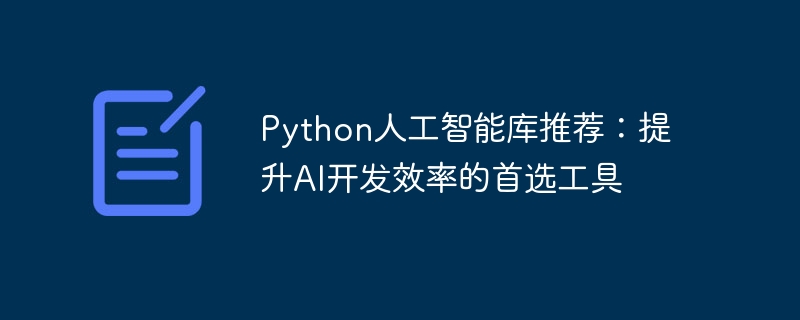Home >Backend Development >Python Tutorial >Recommended artificial intelligence development library: the preferred tool to improve AI development efficiency
Recommended artificial intelligence development library: the preferred tool to improve AI development efficiency
- WBOYWBOYWBOYWBOYWBOYWBOYWBOYWBOYWBOYWBOYWBOYWBOYWBOriginal
- 2023-12-23 12:46:061606browse

Python Artificial Intelligence Library Recommendation: The preferred tool to improve AI development efficiency
Introduction:
With the rapid development of artificial intelligence technology, more and more Developers are beginning to pay attention to and use Python to develop AI projects. However, to develop artificial intelligence in Python, in addition to the basic knowledge of Python, you also need to master some related artificial intelligence libraries. In this article, I will recommend some of the most popular and widely used artificial intelligence libraries in Python, and provide some specific code examples to help readers get started quickly.
- TensorFlow
TensorFlow is an open source artificial intelligence library developed by Google. It provides a rich API for building and training artificial neural networks. TensorFlow is highly scalable, efficient and flexible. The following is a simple example of using TensorFlow for image classification:
import tensorflow as tf
from tensorflow import keras
# 导入数据集
(x_train, y_train), (x_test, y_test) = keras.datasets.mnist.load_data()
# 构建模型
model = keras.Sequential([
keras.layers.Flatten(input_shape=(28, 28)),
keras.layers.Dense(128, activation='relu'),
keras.layers.Dense(10, activation='softmax')
])
# 编译和训练模型
model.compile(optimizer='adam', loss='sparse_categorical_crossentropy', metrics=['accuracy'])
model.fit(x_train, y_train, epochs=5)
# 评估模型
test_loss, test_acc = model.evaluate(x_test, y_test)
print('Test accuracy:', test_acc)- PyTorch
PyTorch is an artificial intelligence library open sourced by Facebook. It uses dynamic graphs to build and train models. . PyTorch provides a rich API to facilitate developers to implement deep learning-related tasks. Here is a simple example of using PyTorch for natural language processing:
import torch
import torch.nn as nn
import torch.optim as optim
# 定义模型
class LSTM(nn.Module):
def __init__(self, input_size, hidden_size, num_layers, output_size):
super(LSTM, self).__init__()
self.hidden_size = hidden_size
self.num_layers = num_layers
self.lstm = nn.LSTM(input_size, hidden_size, num_layers, batch_first=True)
self.fc = nn.Linear(hidden_size, output_size)
def forward(self, x):
h0 = torch.zeros(self.num_layers, x.size(0), self.hidden_size).to(device)
c0 = torch.zeros(self.num_layers, x.size(0), self.hidden_size).to(device)
out, _ = self.lstm(x, (h0, c0))
out = self.fc(out[:, -1, :])
return out
# 导入数据集
train_dataset = ...
train_loader = torch.utils.data.DataLoader(train_dataset, batch_size=64, shuffle=True)
# 构建模型
device = torch.device('cuda' if torch.cuda.is_available() else 'cpu')
model = LSTM(input_size, hidden_size, num_layers, output_size).to(device)
# 定义损失函数和优化器
criterion = nn.CrossEntropyLoss()
optimizer = optim.Adam(model.parameters(), lr=learning_rate)
# 训练模型
total_step = len(train_loader)
for epoch in range(num_epochs):
for i, (sequences, labels) in enumerate(train_loader):
sequences = sequences.to(device)
labels = labels.to(device)
# 前向传播和反向传播
outputs = model(sequences)
loss = criterion(outputs, labels)
optimizer.zero_grad()
loss.backward()
optimizer.step()
if (i + 1) % 100 == 0:
print('Epoch [{}/{}], Step [{}/{}], Loss: {:.4f}'
.format(epoch + 1, num_epochs, i + 1, total_step, loss.item()))- scikit-learn
scikit-learn is a Python-based machine learning library that provides a rich set of machine learning tools. Learning algorithms and data preprocessing methods. The API of scikit-learn is simple and easy to use, making it very suitable for beginners to learn and use. The following is a simple example of using scikit-learn for data classification:
from sklearn import datasets
from sklearn.model_selection import train_test_split
from sklearn.neighbors import KNeighborsClassifier
from sklearn.metrics import accuracy_score
# 导入数据集
iris = datasets.load_iris()
X = iris.data
y = iris.target
# 数据集划分
X_train, X_test, y_train, y_test = train_test_split(X, y, test_size=0.2, random_state=42)
# 构建模型
knn = KNeighborsClassifier(n_neighbors=3)
# 模型训练
knn.fit(X_train, y_train)
# 模型预测
y_pred = knn.predict(X_test)
# 模型评估
accuracy = accuracy_score(y_test, y_pred)
print('Accuracy:', accuracy)Conclusion:
This article recommends three of the most popular and widely used artificial intelligence libraries in Python: TensorFlow, PyTorch and scikit-learn, with specific code examples for each library. Mastering these libraries will greatly improve the efficiency of AI development and help developers realize various artificial intelligence tasks faster. I hope this article can be helpful to readers in Python artificial intelligence development.
The above is the detailed content of Recommended artificial intelligence development library: the preferred tool to improve AI development efficiency. For more information, please follow other related articles on the PHP Chinese website!
Related articles
See more- What is the difference between c language and python
- What are the four elements of an artificial intelligence system?
- What are the main driving forces for the development of artificial intelligence?
- What are the applications of artificial intelligence in life?
- The impact of artificial intelligence on our lives

